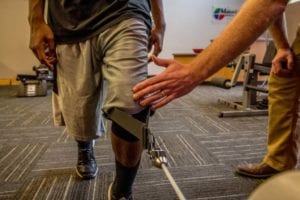It can be difficult to tell the difference between a knee strain and sprain, so we asked one of our experts to help sort through this information for you to make it easier to understand.
What is the difference between a sprain and a strain?
A sprain involves an overstretching of ligaments (tissue that attaches bone to bone) while a strain refers to the overstretching of tendons (tissue that attaches muscle to bone) or overstretching muscles themselves.
What causes a strain or sprain?
Common causes of these injuries include lifting heavy objects with poor body mechanics, falls, lack of flexibility, weakness, collisions such as those during an athletic event, and repetitive motion.
What does a sprain or strain feel like?
Symptoms of a knee sprain or strain include stiffness, swelling, bruising, feeling of instability, pain, and tenderness. Luckily, most symptoms associated with strains and sprains improve with conservative management and do not require imaging or surgery.
Are there different types of sprains?
- Grade I: mild tear with little to no joint instability
- Grade II: moderate tearing with mild to moderate instability
- Grade III: complete rupture or tear and often difficult to bear weight or walk as the joint is unstable
How do I know if I need to see a physician?
It’s time to see a physician if you are unable to walk immediately following the injury, have tenderness directly over the bone in the involved joint, have an obvious deformity, or have numbness in any part of the injured area.
How can I tell if I have a strain vs. a sprain?
That’s the tricky part. It may require the help of a physical therapist to take a thorough history of the mechanism of injury as well as any potential contributing factors to your pain or dysfunction. The therapist will also work through a series of tests and measures to identify the source of pain and any deficits related to the involved knee.
If you think you may have a knee sprain or strain, call any of our clinics to set up your FREE complimentary consult today! We’re here to help you.
McKenna Setlik PT, DPT

